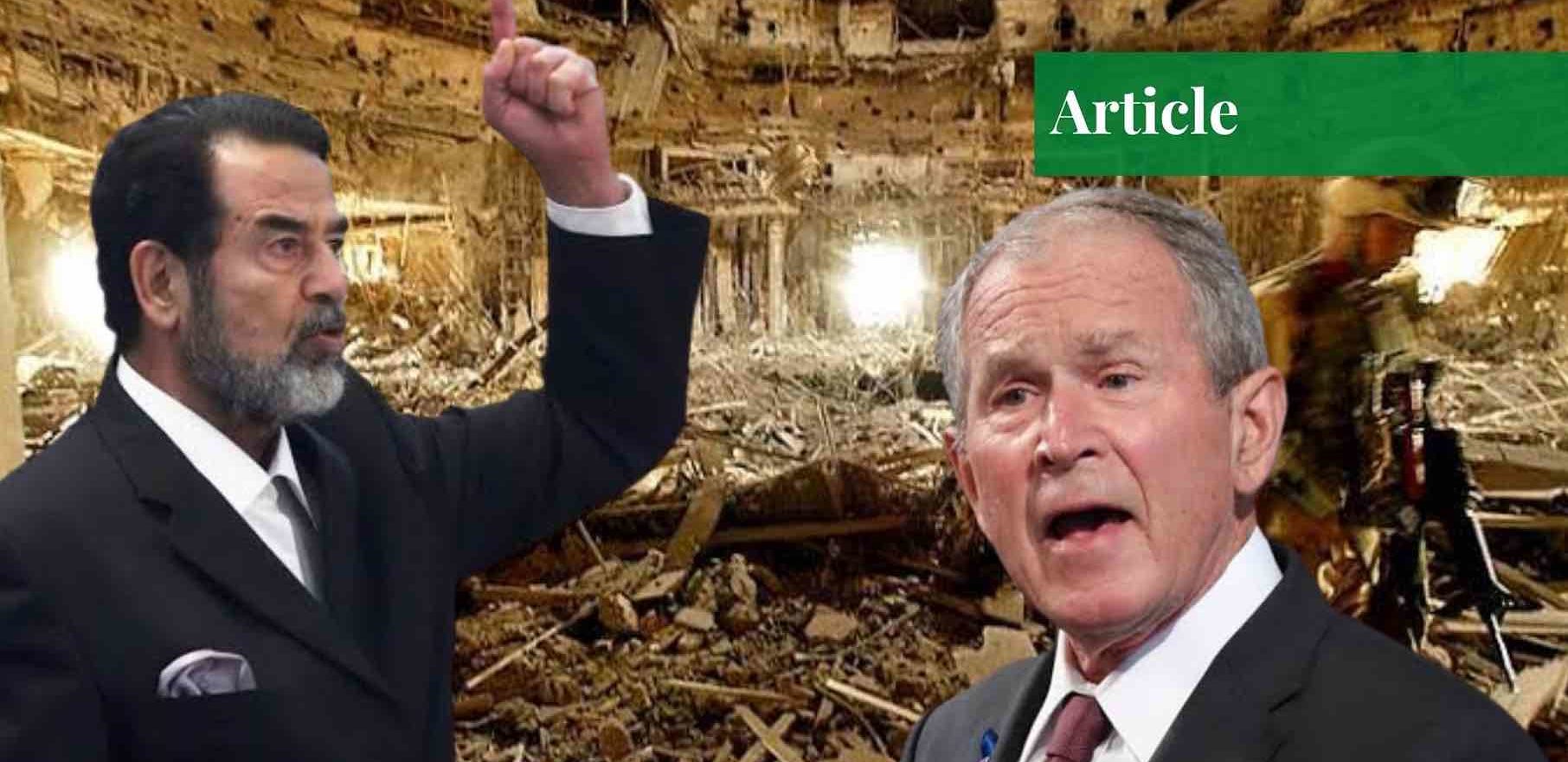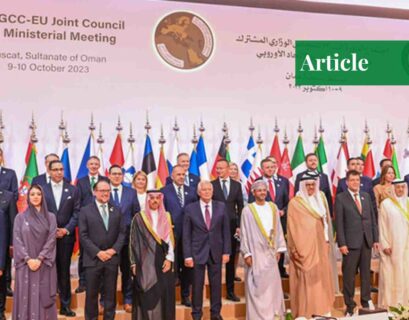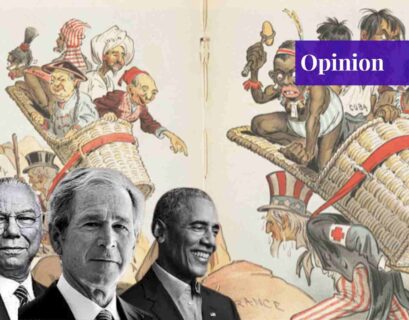Introduction
“It was the decision of one man to launch a wholly unjustified and brutal invasion on Iraq”, stated former President George Bush on 19th May 2022. He then corrected himself and said that he meant “Ukraine.” This recent declaration calls upon in question, a revisit of the US-Iraq relations which began as “friendly” in 1979 and stretched into escalations after the US invaded Iraq by the turn of the century. As the dawn of a new millennium uprose, so did the enmity between these two states i.e., US and Iraq.
The US unleashed a “brutal” and an “unjust” invasion of Iraq in 2003. This is a tale of that invasion, a tale of destruction and war crimes. This is a tale of injustice born out of the wrong choice of one man—George W. Bush Jr. Diplomatic relations between Iraq and the USA began in 1930. From indifference to a gradual alliance to a quick enmity, the relations thereafter fluctuated a lot.
The 1980s are characterized as “friendly years” which took an ugly turn in 1991 as the Persian Gulf War began to pave. In 2003, upon the false accusations of being in possession of weapons of mass destruction (WMDs) and under the guise of humanitarian intervention, the US invaded Iraq. The direct military action took an unprecedented turn and shaped a crisis, a catastrophe, a brutal violation of state sovereignty, and human rights violations.
It is often said that the US had little fear for the weapons and even little concern for Iraqi democracy. Rather, the US invaded Iraq to put on a show of demonstration, a show of the beginning of a rippling effect throughout the Arab world which left in its wake, a trail of chaos and destruction.
Revisiting History
Before embarking on a journey of this tale, it is necessary to take a look into Iraq’s political history and its relations with the US. As a state harboring a population of around 40.22 million people, it is the third-largest state in the Middle East and a direct competitor of Saudi Arabia and Iran, or at least it was until the US-led invasion in 2003 pushed it into an abyss of economic devastation and political turmoil. Once identified as the “cradle of civilizations” with an ethnically diverse population, Iraq has .turned into a grave of civilizations since the US invaded it in 2003.
Its history in correspondence with the US and modern geopolitical scenario is quite a recent development i.e., in the years following World War II. It was within these few decades that Iraq went from being an independent and a major oil producer state with a strong economy to a country under economic sanctions, gradually descending into utter destruction. These horrid consequences were the results of an unjust war on Iraq under the false mask of democracy and misattributing accusations of WMDs. It is to be noted that the war on Iraq had two episodes: “war of necessity” and “war of choice.”

War of Necessity
It is arguably stated that the war on Iraq began quite a while before the actual invasion began i.e., in 1990 when the US-Iraq relations de-escalated in the face of growing apprehension of Iraq taking under siege the Kuwaiti oil. It was in the aftermath of the Gulf War which had adverse consequences on Iraq. Already in devastation from a decade-long episode of war with Iran (1979-89), Iraq was in decline with its oil exports nearly coming to a standstill while millions were being spent on defense.
The economic progress it enjoyed before the war seemed like a distant mirror. Economically and militarily devastated, Iraq sought to find solace in further fighting. It was in a dire need of reconstruction, and President Saddam sought after it in offensive ways i.e., just five days after the ending of the war, a strategic campaign against its southern neighbor – Kuwait – was carried out.
Saddam Hussein invaded Kuwait on 2nd August 1990 and declared it the 19th province of Iraq. This action was met with an international bombardment of condemnation and Iraq was given a deadline by the UN to reverse its action by January 1991. But President Saddam had other plans and steered the direction of his troops towards the Kingdom of Saudi Arabia, which turned to America.
This is when the US declared war on Iraq, fastening the way for its troops on Iraqi soil, and soon launched Operation Desert Shield to oust Iraqi troops from the Persian Gulf. The US started deploying its troops throughout the region, steering clear its path for further interventions, for further wars. This confrontation resulting in a full-fledge conflict is recalled as “the war of necessity” by the US, justifying it as an act of restoration of the disturbed balance of power.
Many scholars associate this US action of invasion of Iraq with a hegemonic action, trying to restore peace disturbed by a revisionist state, but in reality, nearly everyone knows that the US only wanted to protect the oil and petroleum reserves in Kuwait. It was the beginning of the attack that later spread its wings in 2003. It was the sowing of seeds of enmity, maybe even an early warning of what was to follow.
Sanctions And Suffering
The international forum was deeply against Saddam and his regime. Such a well-spread circulation of western propaganda resulted in two-fold unrest in Iraq i.e., civil strifes alongside international sanctions and UN-imposed trade barriers. It is estimated that due to the enforcement of the trade embargo on Iraq by the UN, thousands of Iraqis lost their lives. People, children, and many civilians, for the next decade, lived under inhumane conditions with 60% of the population being malnourished.

This suffering was the consequence of the UN sanctions which resulted in the loss of trade and economy. Thus, Iraq fell from being a metropolis and an oil-rich Arab nation into shambles. Amidst such uncertainty, militant groups found Iraq a haven for hiding, providing an excuse for the US to lead another attack, another invasion which was to be the deadliest blow.
War of Choice
It was believed that Iraq was in possession of biological and chemical weapons, and other weapons of mass destruction. The UN offered to soften the path for trade with Iraq, but only on the condition that Iraq destroys all its weapons as well as end its nuclear program. But the refusal of complying with these stipulations on behalf of Saddam Hussein resulted in the ex-communication of Iraq for more than a decade.
Gradually the internal social fabric fell apart and eventually resulted in small guerilla wars. Even in that ongoing turbulence, Saddam Hussein maintained his stance on weapons, basically implying to the international world that he and his regime had weapons of mass destruction that he was going to use for defense purposes. However, in reality, Iraq had none—as it was discovered later in 2003 after the US had already invaded it.
Iraq was picturized as a terrorist state in the eyes of the international world. Thus, this led to US President, Bill Clinton ordering strategic strikes throughout Iraq in 1998. This attack was named “Operation Desert Fox” and was undertaken by American and British planes. The planes targeted the northern and southern borders of Iraq mainly to damage and limit their capability of WMDs.
This was a four-day-long offensive campaign that led to the discovery of no WMDs but contributed to various causalities. It was a deadly bombing of Iraq during which thousands of people died, mostly civilians, women, and children.
It was witnessed that Iraq had no WMDs to even begin with, but the bombings, the strikes, and airpower show kept incoming. The legacy of this attack continued in the next years through military and economic containment of Iraq but the scenario totally changed in the wake of the September 11 attacks.
9/11 altered the course of history and the world, providing the US with excuses to openly bomb various Muslim states with unjustified impulses. Among them was Iraq as well. Whether a tragedy or a strategy, September 11 made Washington turn up the heat against Iraq once again. Under the presidency of George W. Bush, the USA declared the three states of Iraq, Iran, and North Korea as the axis of evil, and subsequently took actions against them.
The UN refused to adhere to Washington’s demands to pass a resolution against Iraq’s apparently reported WMDs, leading the USA to take the fate of Iraq into its own hands, and thus Iraq once again suffered from great devastation under vast destruction as a consequence of another invasion led by the US. Yet another war carried out by the US, a war raged by choice rather than by necessity, a war imposed on innocent people by the blind-sightedness of one man.
The bombing of Baghdad started in March 2003 under “Operation Iraq Freedom” but there was nothing free about it. It was an extremist and offensive action by the US only to break Saddam’s stronghold in Iraq without any realization of the consequences it will provide for the general public. For the next three weeks, the bombing continued followed by ground troops entering the capital while people watched this international crisis unfold in “shock and awe.”
By April, Baghdad was under the control of the US while Saddam himself was on the run, thus, resulting in a vacuum that many individual and group organizations from varying marginalized religious and ethnic backgrounds were eager to fill. While the US officials were on the hunt for Saddam, the internal chaos escalated resulting in the formation of many radical groups.
On 1st May 2003, the attacks in Baghdad came to a halt, but the internal battlefield was still hot. The WMDs which Saddam used to boast about weren’t found anywhere in Iraq but the entire state was put in crisis, with the lives of the people turned upside down during the war. The responsibility of this war lies with the USA, highlighting forever its act of making a wrong choice. A choice that led to smoke hues and battle cries of civilian bystanders.
The fault vests in the hands of the CIA, which was sufficiently incapable of gathering the true and right intelligence before invading Iraq. The US carried out its activities under the masks of “democracy and freedom” but the invasions and war paint an opposite picture, a picture of destruction and devastation which made the state fall into a pit of misery from which it still hadn’t recovered.
Analysis
The presence of US military troops can be witnessed in Iraq for the past 19 years, causing problems. Ever since 1991, the US and Iraq had conflicting relations with each other, resulting in various attacks and clashes leading to the death of millions. A full-fledged attack on the soil of Iraq was launched in March 2003, leaving in its wake absolute chaos.
But even after two decades, the chapter hasn’t been closed, provided that Iraq hasn’t recovered from its shambles. Although one can state that this US invasion of Iraq is history, a horrible past. But history is to be remembered, to be read and learned from. And this very dark episode of history demands a revisit, given the recent accidental confession of G.W. Bush to his war crimes in Iraq, calling the “war on Iraq,” a “decision of one man,” a “brutal” and an “unjustified” decision.
If you want to submit your articles, research papers, and book reviews, please check the Submissions page.
The views and opinions expressed in this article/paper are the author’s own and do not necessarily reflect the editorial position of Paradigm Shift.



















